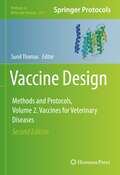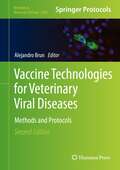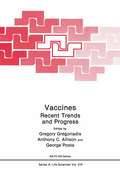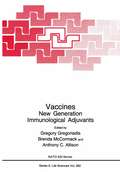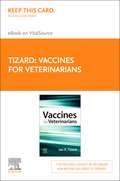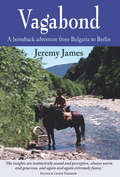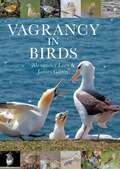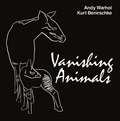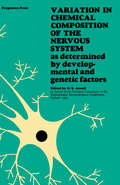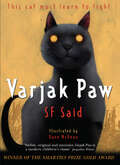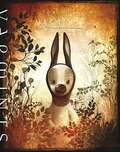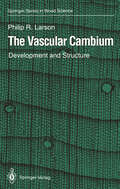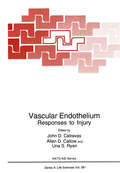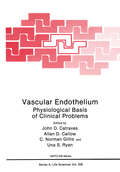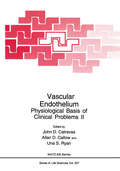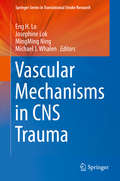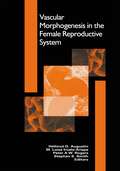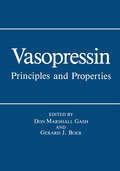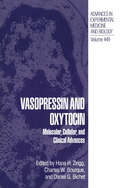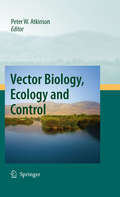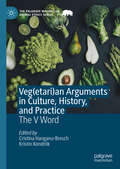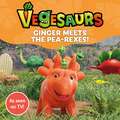- Table View
- List View
Vaccine Design: Methods and Protocols, Volume 2. Vaccines for Veterinary Diseases (Methods in Molecular Biology #2411)
by Sunil ThomasThis volume provides a practical guide providing step-by-step protocol to explore vaccines for farm and companion animals, as well as for fish and insects. Divided into three volumes, Volume 2: Vaccines for Veterinary Diseases guides readers through veterinary vaccines, vaccines for poultry, vaccines for farm animals, and vaccines for veterinary parasites. Written in the format of the highly successful Methods in Molecular Biology series, each chapter includes an introduction to the topic, lists necessary materials and reagents, includes tips on troubleshooting and known pitfalls, and step-by-step, readily reproducible protocols. Authoritative and practical, Vaccine Design: Methods and Protocols, Second Edition, Volume 2: Vaccines for Veterinary Diseases aims to be a useful practical guide to researchers to help further their study in this field.
Vaccine Technologies for Veterinary Viral Diseases: Methods and Protocols (Methods in Molecular Biology #2465)
by Alejandro BrunThis second edition includes a collection of antigen production and delivery strategies for vaccine development in veterinary species. New and updated chapters guide readers through protocols for antigen production, experimental antigen delivery and the analysis of immune responses upon vaccination. Written in the format of the highly successful Methods in Molecular Biology series, each chapter includes an introduction to the topic, lists necessary materials and reagents, includes tips on troubleshooting and known pitfalls, and step-by-step, readily reproducible protocols. Authoritative and cutting-edge, Vaccine Technologies for Veterinary Viral Diseases: Methods and Protocols, Second Edition aims to be a useful and practical guide to researches to help further their study in this field.
Vaccines: Recent Trends and Progress (Nato Science Series A: #215)
by Anthony C. Allison Gregory Gregoriadis George PosteThe success of vaccination in controlling infectious diseases is well documented. However, low profitability, expense and liability have hindered research and development of vaccines. Recently, increasing realization (enhanced by the AIDS pandemic) of the need to overcome such difficulties has led to steps being taken by national authorities, non-profit and commercial organizations to resolve them. This has been facilitated by developments in recombinant DNA techniques, the advent of monoclonal anti bodies and progress in the understanding of the immunological structure of proteins which have laid the foundation of a new generation of vaccines. Such vaccines are defined at the molecular level, can elicit immune responses controlling infectious organisms and are therefore potentially free of the problems encountered in conventional ones. Unfortunately, subunit and synthetic peptide vaccines are often only weakly or non inmunogenic. However, developments in both antigen production and immuno potentiation of weak antigens have opened new avenues with exciting prospects for vaccine design.
Vaccines: New Generation Immunological Adjuvants (Nato Science Series A: #282)
by Gregory Gregoriadis Brenda McCormack Anthony C. AllisonDuring the last decade or so vaccine development has been facilitated by rapid advances in molecular and cell biology. These have laid the foundations of a new generation of vaccines exemplified by subunit vaccines produced through gene cloning and by synthetic peptides mimicking small regions of proteins on the outer coat of viruses. Such peptide~ are capable of eliciting virus-neutralizing antibodies. Unfortunately, subunit and peptide vaccines are only weakly or non immunogenic in the absence of immunological adjuvants that are known to augment specific cell-mediated immune responses to the antigens and to promote the formation of protective antibodies. This book contains the proceedings of the 4th NATO Advanced Studies Institute (ASI) "Vaccines: New Generation Immunological Adjuvants" held at Cape Sounion Beach, Greece, during 24 June -5 . July 1994 and deals in depth with both theoretical and practical aspects of vaccinology. These include the role of antigen presenting cells in the induction of immune responses. immunopotentiation by a variety of new generation immunological adjuvants and vaccine carriers. and recent advances and perspectives in experimental vaccines as well as vaccinatioll with nucleic acids. We express our appreciation to Dr. K. Dalsgaard and Dr. J. L. Virelizier for their cooperatioll in planning the ASI and to Mrs. Concha Pening for her excellent production of the manuscripts. The ASI was held under the sponsorship of NATO Scientific Affairs Division and generously co-sponsored by SmithKline Beecham Pharmaceuticals (Philadelphia).
Vaccines for Veterinarians E-Book
by Ian R. TizardBoth a theoretical text and a practical handbook, Vaccines for Veterinarians is the first of its kind to bring the basic science of animal vaccination and the practical details of vaccine use together in one single volume. From the first chapter on the history of vaccination and the triumph of rinderpest eradication to the last chapter on the rapidly emerging field of cancer vaccines, this book offers a truly comprehensive grounding in established and emerging vaccines for both major and minor species. Specific topics include viral vectored vaccines, DNA-plasmid vaccines, RNA vaccines, reverse vaccinology, the complexities of adjuvant use, vaccine failures and adverse events, vaccine production and regulation, robotic vaccination machines, contraceptive and production-enhancing vaccines, and so much more. At a time when resistance to human vaccination is receiving much publicity, this evidence-based book is the ideal counter to ill-informed speculation — serving as a timely reminder that vaccination is essential for the control of infectious diseases in animals.Well-respected and experienced veterinary author, Ian Tizard, provides expert guidance on the topic of vaccinations and immunology in veterinary medicine.Expert Consult site offers an online version of the book, making it easy to search the entire book electronically. The latest information on viral vectored vaccines keeps you up-to-date on the topic as well as the properties and relative advantages of currently used vectors in animal vaccines.Survey of vaccine responses covers the different mechanisms by which the immune system responds to different types of vaccines.Inclusion of the latest vaccine technologies discusses the advantages and disadvantages of DNA-plasmid vaccines, RNA vaccines, and more.Coverage of adverse events and hypersensitivities includes the best ways to treat them and report them.Coverage of passive immunization discusses the growing use of therapeutic monoclonal antibodies in veterinary medicine.Coverage of immunotherapy includes recent improvements and new products in both active and passive immunotherapy against animal cancers.
Vagabond: A Horseback Adventure from Bulgaria to Berlin
by Jeremy JamesThe journey starts when author and long-rider Jeremy James buys two horses from gypsies at a fair in southern Bulgaria. He and his long-suffering friend Chumpie then set off on horseback, winding northwards to Berlin, and on the way they encounter a marvellous array of local characters from all walks of life as they ride from Bulgaria to Berlin, via Romania, Hungary, Czechoslovakia and Poland. On a low budget, they are sustained by local fire-water, indigestible food and the forceful personalities of their horses who steal, run away, misbehave or suddenly comply at will and add a whole new dimension to the experience of travel. After five long months, they finally reach their destination. It has taken Jeremy through an Eastern Europe full of surprises, which, with the collapse of communism, has almost disappeared today.
Vagrancy in Birds
by Alexander Lees James GilroyThe first comprehensive coverage of a subject that has fascinated natural historians for centuries.Avian vagrancy is a phenomenon that has fascinated natural historians for centuries. From Victorian collectors willing to spend fortunes on a rare specimen, to today's high-octane bird-chasing 'twitchers', the enigma of vagrancy has become a source of obsession for countless birders worldwide.Vagrancy in Birds explores both pattern and process in avian vagrancy, drawing on recent research to answer a suite of fundamental questions concerning the occurrence of rare birds. For each avian family, the book provides an in-depth analysis of recent and historical vagrancy patterns, representing the first comprehensive assessment of vagrancy at a global scale. The accounts are accompanied by hundreds of previously unpublished images featuring many of the most exceptional vagrants on record.The book synthesises for the first time everything we know about the subject, making the case for vagrancy as a biological phenomenon with far-reaching implications for avian ecology and evolution.
Vagrancy in Birds
by Alexander Lees James GilroyThe first comprehensive coverage of a subject that has fascinated natural historians for centuries.Avian vagrancy is a phenomenon that has fascinated natural historians for centuries. From Victorian collectors willing to spend fortunes on a rare specimen, to today's high-octane bird-chasing 'twitchers', the enigma of vagrancy has become a source of obsession for countless birders worldwide.Vagrancy in Birds explores both pattern and process in avian vagrancy, drawing on recent research to answer a suite of fundamental questions concerning the occurrence of rare birds. For each avian family, the book provides an in-depth analysis of recent and historical vagrancy patterns, representing the first comprehensive assessment of vagrancy at a global scale. The accounts are accompanied by hundreds of previously unpublished images featuring many of the most exceptional vagrants on record.The book synthesises for the first time everything we know about the subject, making the case for vagrancy as a biological phenomenon with far-reaching implications for avian ecology and evolution.
Vanishing Animals
by Andy Warhol Kurt BenirschkeEspecially for this book, Andy Warhol has created prints (silkscreen over collage) of some of the most endangered animals in the world. Here they are joined with a stimulating text by Dr Kurt Benirschke affording the reader an opportunity to discover the lives and habits of these animals and what the outlook is for their survival.Extinction, the tragic and permanent loss of entire species of animals, should be a concern for everyone This concern and a strong desire to take action toward preventing the loss of more animals has brought about an unusual collaboration between art and science. The result is this beautiful volume in which artist and scientist have joined efforts to inform and inspire others to take action. It is hoped that these fascinating and striking portrayals will stimulate readers to join their own energies and talents to this important fight against the loss of more species. This book brings some of the less well known endangered animals to the reader's attention. These animals deserve just as much attention as the giant panda or the mountain gorilla about which so much has already been said. Naturally, the animals presented here are very personal choices, having been selected from a virtually endless supply of animals whose last hour is rapidly approaching.
Variation in Chemical Composition of the Nervous System: As Determined by Developmental and Genetic Factors
by G. B. AnsellVariation in Chemical Composition of the Nervous System: As Determined by Developmental and Genetic Factors documents the proceedings of the International Neurochemical Conference held in Oxford, 1965. The three years since the last neurochemical meeting have witnessed rapid progress in the whole field of biology, including the development of new concepts based on fresh experimental data and new technical tools. A great deal of concentrated effort have led to advances in the molecular aspects of biological processes ,which have perhaps had most to offer to the formation of new concepts of primary cellular events, especially the genetic mechanism, regulatory cell processes, and protein production. This volume contains 100 chapters that provide an overview of the state of knowledge on the genetic and developmental aspects of the central nervous system. Topics covered include the activity of a plasma logenase in the brain of the developing rat; genetic selection of rats differing in brain biochemistry; the effects of thyroid hormones on steroid deposition in developing chick brain; and developmental changes in the gamma globulins of bovine cerebrospinal fluid.
Varjak Paw (Varjak Paw #1)
by Sf Said Dave McKeanVarjak Paw is a Mesopotamian Blue kitten. He lives high up in an old house on a hill. He's never left home, but then his grandfather tells him about the Way - a secret martial art for cats.Now Varjak must use the Way to survive in a city full of dangerous dogs, cat gangs and, strangest of all the mysterious Vanishings.
Varmints: Striking, surreal illustrations and a haunting, evocative text tell a mysterious tale of a threatened natural world, and a hopeful new start.
by Helen WardOnce, the only sounds to be heard were the buzzing of bees in the grass, the murmuring of moles in the earth, and the song of birds in the sky. These warmed the hearts of those who cared to listen - until the others came to fill the sky with a cacophony of noise. With dramatically lit artwork and a spare, intriguing text, Varmints tells of a pastoral world in need of protection and of the souls who love it enough to ensure its regeneration.
The Vascular Cambium: Development and Structure (Springer Series in Wood Science)
by Philip R. LarsonThe cambium has been variously defined as follows: "The actively dividing layer of cells that lies between, and gives rise to, secondary xylem and phloem (vascular cambium)" (IAWA 1964); "A meristem with products of periclinal divisions commonly contributed in two directions and arranged in radial files. Term pre ferably applied only to the two lateral meristems, the vascular cambium and cork cambium, or phellogen" (Esau 1977); and, "Lateral meristem in vascular plants which produces secondary xylem, secondary phloem, and parenchyma, usually in radial rows; it consists of one layer of initials and their undifferentiated deriva tives" (Little and Jones 1980). Clearly, the cambium is a diverse and extensive meristem, and no one defini tion will encompass all manifestations of what anatomists consider cambium. Its diversity and extent are further exemplified by a single plant, such as a temperate zone tree, in which procambium is initiated in the embryo and perpetuated throughout every lateral, primary meristem before giving rise to cambium in the secondary body. The cambium thereafter performs its meristematic task of producing daughter cells that differentiate to specialized tissue systems. The cam bium, however, does not remain static. Its derivatives vary either in form, or TImc tion, or rate of production at different positions on the tree, with age of the tree, and with season of the year. Moreover, the cambium responds both to internal sig nals and to external stimuli such as environment or wounding.
Vascular Endothelium: Responses to Injury (Nato Science Series A: #281)
by Allan D. Callow John D. Catravas Una S. RyanProceedings of a NATO ASI held in Limin Hersonissou, Greece, June 18-27, 1994.
Vascular Endothelium: Physiological Basis of Clinical Problems (Nato Science Series A: #208)
by John D. Catravas Allan D. Callow C. Norman Gillis Una S. RyanThis monograph contains the proceedings from the Advanced Study Institute on "Vascular Endothelium: Physiological Basis of Clinical Problems" which took place in Corfu, Greece in June 1990. The meeting consisted of twenty-eight lectures, most of them adapted as full length papers in this volume, as well as numerous short oral and poster communications which are abstracted and also included in alphabetical order (pages 239-302). There were ninety-six participants from ten NATO and four other European countries. The meeting was the second in as many years dealing with a specific subject in Endothelial Cell biology. Following the 1988 discussion on "Receptors and Transduction Mechanisms", the present ASI recognized and tried to deal with the increasing overlap in interest between basic scientists studying endothelial cell functions and clinicians facing problems of known or suspected endothelial pathological involvement. As with any similar effort, we opted to be selective, rather than fail by trying to be inclusive, in the subjects covered. We chose to discuss diseases, such as atherosclerosis, sepsis, ARDS and stroke, based on their relevance to endothelial cell function and urgent need for new insights into their pathogenesis and treatment. Similarly, we examined endothelial cell functions by considering their relevance to disease and their potential for elucidating important pathologies. Obviously, some areas were covered superficially or not at all; this should not distract from their importance, but rather reflect on the constraints of time and -not at all negligibly -the bias of the organizing committee.
Vascular Endothelium: Physiological Basis of Clinical Problems II (Nato Science Series A: #257)
by John D. Catravas Allan D. Callow Una S. RyanThis book is a compilation of the lectures and oral and poster communications presented at the Advanced Study. Institute on "Vascular Endothelium: Physiological Basis of Clinical Problems II," which took place between June 20 and 30, 1992 in Rhodes, Greece. This third in a series of ASIs on vascular endothelium continued on the theme of the first (1988) ASI on "Receptors and Transduction Mechanisms" and particularly expanded that of the 1990 conference on ''Physiological Basis of Clinical Problems. " We continued the successful practice of bringing together clinicians and scientists: this was reflected equally well in the composition of the organizing committee as in the background of the particiJ?ants. Endothelial cell functions and dysfunctions present as many challenges to the mvestigator as they do to the curious clinical practitioner. As these problems are necessarily different, this unique ten-day co-habitation of these individuals continued to offer fresh outlooks to each, stimulated potential collaborative efforts and, most importantly, advanced --ever so slightly--our knowledge of vascular biology. This year's conference was further enriched by the presence of several of our colleagues from Eastern Europe whom we are delighted to welcome as officially sponsored participants to this and future NATO-supported meetings. It is never superfluous to remind readers and participants that those signing at the bottom of this page, while responsible for many of the ASI's and the book's deficiencies, are but three of the many contributors to the successes.
Vascular Mechanisms in CNS Trauma (Springer Series in Translational Stroke Research #5)
by Eng H. Lo Josephine Lok MingMing Ning Michael J. WhalenWhile there are a number of books on the market that deal with neuronal mechanisms and targets, the proposed book will be the only one to cover the vascular aspects of CNS trauma. The contributing authors will present basic mechanisms, explain cutting-edge experimental models and techniques, and provide several clinical chapters that provide treating physicians with some insight on the cases that they see in the ICU. The table of contents is diverse and comprehensive with chapters on molecular mechanisms, physiology, pharmacology, stem cells, genomics and proteomics, in vivo MRI and PET, as well as the clinical management of vascular parameters.
Vascular Morphogenesis in the Female Reproductive System (Cardiovascular Molecular Morphogenesis)
by Hellmut G. Augustin M. Luisa Iruela-Arispe Peter A. W. Rogers Stephen K. SmitheThe overall scope of this new series will be to evolve an understanding of the genetic basis of (1) how early mesoderm commits to cells of a heart lineage that progressively and irreversibly assemble into a segmented, primary heart tube that can be remodeled into a four-chambered organ, and (2) how blood vessels are derived and assembled both in the heart and in the body. Our central aim is to establish a four-dimensional, spatiotemporal foundation for the heart and blood vessels that can be genetically dissected for function and mechanism. Since Robert DeHaan's seminal chapter "Morphogenesis of the Vertebrate Heart" published in Organogenesis (Holt Rinehart & Winston, NY) in 1965, there have been surprisingly few books devoted to the subject of cardiovascular morpho genesis, despite the enormous growth of interest that occurred nationally and inter nationally. Most writings on the subject have been scholarly compilations of the proceedings of major national or international symposia or multi authored volumes, without a specific theme. What is missing are the unifying concepts that can often make sense out of a burgeoning database of facts. The Editorial Board of this new series believes the time has come for a book series dedicated to cardiovascular mor not only as an important archival and didactic reference phogenesis that will serve source for those who have recently come into the field but also as a guide to the evo lution of a field that is clearly coming of age.
Vasopressin: Principles and Properties
by G. J. Boer Don GashThe concept for Vasopressin: Principles and Properties originated during the sum mer of 1983. From reviewing the rich and diverse literature on vasopressin, it became evident that the rapid advancements in this field made it difficult to syn thesize the information gathered from divergent scientific disciplines into a coherent view of the biological role of vasopressin. We perceived the need for a series of critical reviews delineating this recent progress. Over the past decade, major advances have been made in studies of the anatomy, physiology, phar macology, molecular biology, and behavioral activities of vasopressin. This is, in no small measure, due to the finding that vasopressin can no longer be regarded solely as a neurohypophysial hormone. Our present knowledge is that vasopressin is synthesized in also has an axonal messenger role in the nervous system and of the brain, although the functions of vasopressin in these periph sites outside of vasopressin eral sites are not well understood. In order to prepare an overview concentrating on recent studies in vertebrates, authors were selected based on their expertise and asked to review their research area, including the work from other laboratories. It was our intent to provide an updated definitive reference which would complement and extend such past texts as Neurohypophysial Hor mones and Similar Polypeptides (Handbook of Experimental Pharmacology, Vol ume XXIII, 1968) and The Pituitary Gland and Its Neuroendocrine Control (Handbook of Physiology, Section 7: Volume IV, 1974).
Vasopressin and Oxytocin: Molecular, Cellular, and Clinical Advances (Advances in Experimental Medicine and Biology #449)
by Hans H. Zingg Charles W. Bourque Daniel G. BichetThis monograph provides a comprehensive overview of recent advances in the field of vasopressin and oxytocin. In the summer of 1997, scientists from over 20 countries congregated in Montreal for the 1997 World Congress of Neurohypophysial Hormones, a conference that united the fields of vasopressin, neurohypophysis and oxytocin in a single joint meeting that gave rise to the present book. The organization of a joint meeting was prompted by several recent developments. Specifically the molecular characterization of the vasopressin/oxytocin receptor family made it mandatory to adopt an integrated view and to discuss the vasopressin/oxytocin ligand/receptor family as a whole. To ensure em phasis on novelty, the conference focused on advances made over the last two years and also included important contributions by scientists that had not previously been associated with the vasopressin/oxytocin field. Vasopressin and oxytocin are two neurohormones that exert a wide spectrum of cen tral and peripheral actions. Accordingly, the vasopressin/oxytocin field embraces a large number of different domains, ranging from neuroscience, endocrinology, and oncology to renal, reproductive, and cardiovascular physiology and pathology.
Vector Biology, Ecology and Control
by Peter W. AtkinsonMir S. Mulla joined the faculty of the Entomology Department at the University of California, Riverside in 1956, only two years after the Riverside campus was established as an independent campus within the University of California system. Prior to his appointment, Mir received his B.S. from Cornell University and then moved to the University of California, Berkeley to pursue his graduate studies. His Ph.D. from Berkeley, awarded in 1955, completed his formal American education which was the purpose of his immigration from his native Kandahar in Afghanistan. In his over 50 years at Riverside, Mir has made an incalculable impact on vector biology both within the United States and in developing countries throughout the world. Within Southern California, Mir’s basic and applied research led to the rapid and sustainable control of mosquitoes and eye gnats in the Coachella Valley and so directly enabled this region to grow to the thriving, large community it is today. In 2006 his efforts in facilitating the development of the low desert of southern California were recognized through the dedication of the Mir S. Mulla Biological Control Facility by the Coachella Valley Mosquito and Vector Control District. His success has been so profound that it remains somewhat cryptic to the many who now reside in, visit, and enjoy, this region of California, oblivious to the insect problems that severely restrained development until Mir and his students ?rst applied their expertise many decades ago.
Veg: The V Word (The Palgrave Macmillan Animal Ethics Series)
by Cristina Hanganu-Bresch Kristin KondrlikThis collection explores the arguments related to veg(etari)anism as they play out in the public sphere and across media, historical eras, and geographical areas. As vegan and vegetarian practices have gradually become part of mainstream culture, stemming from multiple shifts in the socio-political, cultural, and economic landscape, discursive attempts to both legitimize and delegitimize them have amplified. With 12 original chapters, this collection analyses a diverse array of these legitimating strategies, addressing the practice of veg(etari)anism through analytical methods used in rhetorical criticism and adjacent fields. Part I focuses on specific geo-cultural contexts, from early 20th century Italy, Serbia and Israel, to Islam and foundational Yoga Sutras. In Part II, the authors explore embodied experiences and legitimation strategies, in particular the political identities and ontological consequences coming from consumption of, or abstention from, meat. Part III looks at the motives, purposes and implication of veg(etari)anism as a transformative practice, from ego to eco, that should revolutionise our value hierarchies, and by extension, our futures. Offering a unique focus on the arguments at the core of the veg(etari)an debate, this collection provides an invaluable resource to scholars across a multitude of disciplines.
Vegesaurs: Based on the hit CBeebies series
by Macmillan Children's BooksMeet Ginger the Tricarrotops and the mighty Vegesaurs in this picture book adventure, based on the hit CBeebies animated TV seriesGinger the Tricarrotops is on the run from a herd of hungry Pea-Rexes – but what happens when three mischievous baby Peas decide they want to be her friend?Based on the preschool animated series, Vegesaurs: Ginger Meets the Pea-Rexes! is a funny picture book that captures all the adventure and humour of the TV episodes, with themes of friendship, play and healthy eating. Read the exciting story and then enjoy the extra content, including character facts and reading tips.Fans of this book will also enjoy Vegesaurs: Baby Bok's Flying Lesson, another picture book adventure based on the brilliant CBeebies TV series.
